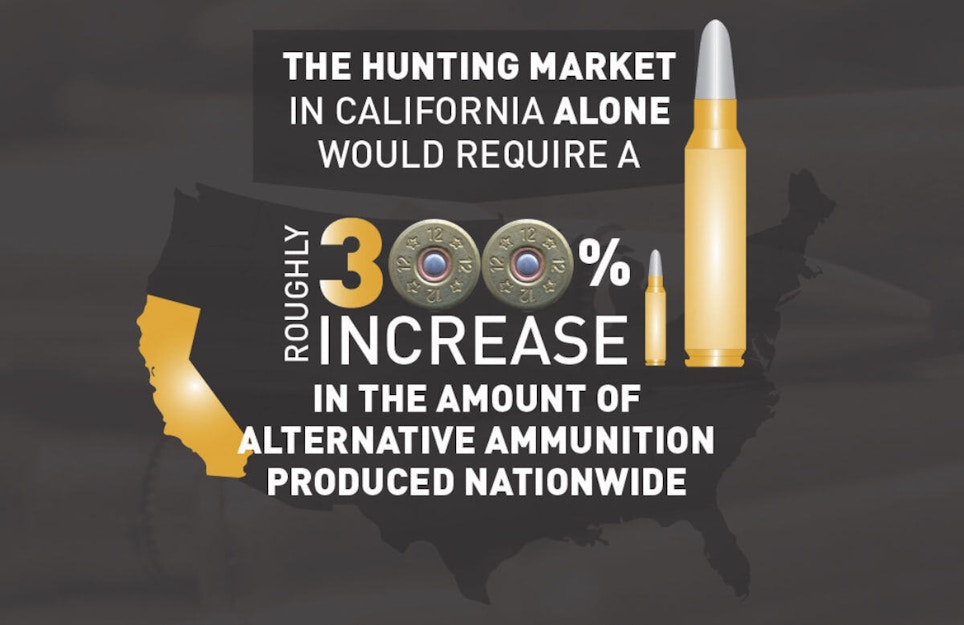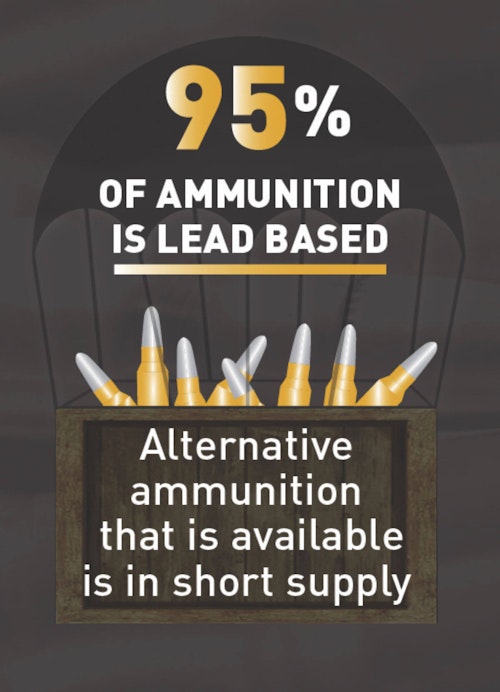In September, the U.S. Fish and Wildlife Service published what is called the Hunt-Fish Rule. While the rule opened up more access to public lands for hunting and fishing, the rule implements both an immediate and phase-out ban of traditional lead ammunition (and fishing tackle) applicable to a number of the opportunities on National Wildlife Refuge lands. This change would force hunters to exclusively use non-lead ammunition in the field, removing from them the ability to choose the ammunition that best meets their needs.
The Biden administration said it would follow the science. The science of wildlife management is based on the fundamental principle that you manage wildlife populations. The Service says in the rule that it relies upon the “best available science.” We took a close look at the studies cited by FWS to see if the science establishes any negative species population impacts caused by hunters’ centuries-long use of traditional ammunition that would justify the ban. The results might surprise you. It certainly disappointed us.
Suspect Sources
Four highly suspect studies were used by the FWS in order to justify their traditional ammunition ban. Hunt et al., 2006 and 2009, are two examples of obfuscation by way of cherry-picked data. The 2006 Hunt study collected deer shot by hunters and provided the carcasses to a veterinarian for X-ray analysis that yielded a scattering of various material inside the animal cavity. Of the material that was highlighted by the X-ray, the authors did not bother to dissect and clearly identify what they were seeing.
It is safe to say that if no dissection was conducted, then the authors were assuming that any mass on the radiograph was lead, not copper or bone. Notably, when this study was conducted, modern bonded bullets were not as prevalent as they are becoming. Bonded bullets are either mechanically or chemically fused together, core and jacket, to prevent loss of bullet mass. This provides greater repeatability and reliability of the hunting bullet. In turn, it also greatly reduces fragmentation over some older cup-and-core designs. Due to the lack of dissection and rarity of bonded bullets during the timeframe of the study, it is reasonable to conclude that this study has lost relevance.
FWS asserts in their rule’s supporting documents, “The impacts of lead on human health and safety have also been a focus of several scientific studies. As related to hunting and fishing, studies have found the ingestion of animals harvested via the use of lead ammunition increased levels of lead in the human body.” The referenced study is a Buenz 2016 editorial, not a peer-reviewed study, that foundationally relied on the newer Hunt study, Hunt et al. 2009.
The research was based in North Dakota and claims 80% of deer harvested with traditional ammunition had metallic lead in the resulting ground venison. Reliance on this editorial and study is misplaced. What the study actually says is, “radiography revealed visible metal fragments in the ground meat of 24 (80%) of the 30 deer. At least one fragment was visible in radiographs of 74 (32%) of 234 packages of ground meat … 160 (68%) revealed no fragments.”
A third of ground venison having some form of visible radiography fragment is vastly different than asserting that lead was found in 80% of ground venison. The obfuscation in this case is likely purposeful. The original use of this study by FWS is also concerning because the Hunt team only used one cartridge and one bullet type, “All bullets were of 7mm Remington Magnum caliber and of identical mass (150 grains, 9,720 mg); cartridges were of a single brand.” Reliance on a single bullet type to cast dispersion on an entire category of ammunition is overreaching at a minimum.
Coincidently, the FWS ignored a relevant North Dakota study published months prior, Iqbal et al. 2008. The study consisted of 740 participants, of which 598 or 80.8%, consumed wild game. Most of the participants, 63.9%, also participated in at least one “lead-related hobby.” The Centers for Disease Control and Prevention tested blood samples from these wild-game-eating North Dakotans and showed that no one had a blood lead level (BLL) of concern. The average BLL of hunters tested was lower than that of the average American, including non-hunters. Additionally, the average BLL of children in the study was 10 times less that of the CDC threshold for concern.
Iowa Department of Public Health also conducted a 15-year BLL study with 500,000 youth under 6 and 25,000 adults and found that no participants had elevated BBLs nor have they had a single hunter with elevated BLLs from consuming harvested game. This data goes against the narrative that traditional lead-component ammunition is a problem which is likely why it was not included in the FWS rulemaking.
Bulletized Assumptions
A Golden et al. 2016 study is also cited by FWS. The authors openly admit there are multiple sources of lead in the environment yet place blame on traditional ammunition and hunters by default. This is purposeful to assert the desired maligning of lead-component ammunition. The study reveals the authors are not subject matter experts on modern ammunition nor ballistics. The authors concentrate on their oversimplified understanding of bullets by making no mention of modern bonded hunting bullets that perform as well or better than copper alternatives.
The FWS cites to Slabe et al. 2022, which cites the previous Golden et al. 2016 study as one of the credible sources on bullet fragmentation. How the Slabe et al. study differs is the complete lack of field-confirmed study in order to come to their conclusion. It is based on a hypothetical model not supported by actual, concrete evidence.
“Hypothetical matrix population models built for both species suggest that if liver lead concentrations above that conservative threshold always result in death, then the continent-wide population growth rates of these species are being suppressed, for bald eagles by 3.8% … and for golden eagles by 0.8%.”
This conclusion is problematic for two reasons. The first is that the source of lead in these animals is assumed. Furthermore, this study’s conclusion is built upon a hypothetical matrix and references studies with questionable data. Less than 4% reduction in population growth is hardly a justification to bar hunters from utilizing the ammunition of their choice considering the conclusion is entirely made up.
An Iowa State University study that conducted actual field research of wild bald eagles proved that very few are suffering from any kind of lead poisoning. Generally, bald eagle testing is conducted on sick birds admitted to wildlife rehabilitation facilities which skews the results. In fact, bald eagles are recovering with widespread utilization of traditional lead ammunition. This recovery is made possible by Pittman-Robertson conservation dollars generated from firearm and ammunition excise taxes — the very ammunition demonized by this and other studies.
Lawsuit After Lawsuit
Given the sorry state of “best available science” used by FWS, the ban makes more sense considering its being sued by the litigious anti-hunting group, the Center for Biological Diversity (CBD). The baseless lawsuit aimed to force a ban on both traditional ammunition and fishing tackle on public lands. The move by CBD is a “sue and settle” scheme to force their will on hunters to which FWS appears to be a willing participant. Rather than oppose the CBD’s lawsuit and seek to have it thrown out of court, FWS immediately entered into settlement discussions. That raised many eyebrows on Capitol Hill and within the conservation community.
In February, the FWS and CBD informed the federal judge that they had reached a tentative settlement agreement but needed more time. Likely time for the CBD to see if the FWS’s Hunt-Fish Rule that had yet to be published addressed their concern underlying the lawsuit.
After the final rule was published, the USFWS and CBD told the court they had reached a settlement and were only negotiating the issue of attorney’s fees. Importantly, the parties told the court the CBD believes the 2022-2023 Rule satisfies many of its goals in this litigation. Why wouldn’t they be pleased? The lawsuit achieved CBD’s intended purpose. A ban not supported by science and imposed on hunters through the rule.
Another CBD lawsuit proves its hypocrisy and anti-hunting agenda. Months after suing FWS, they sued the U.S. Forest Service for attempting to approve a land swap for copper mining. CBD seems to demand the exclusive use of all-copper ammunition yet is actively fighting the means necessary to satisfy that requirement.
Dangerous Precedents
FWS is setting a dangerous precedent of ignoring science and caving to litigious activities with their recent rule. Politics should not dictate wildlife management policy. That move was already tried and failed by former USFWS Director Dan Ashe who attempted to sidestep science and ban traditional ammunition on the last day of the Obama administration. The highly suspect move was overturned by Ryan Zinke, former President Trump’s First Interior Secretary.
NSSF expects the “settlement” to adopt the rule as a consent decree so that it cannot be undone by a future FWS director or Interior Secretary. The CBD — and those within the FWS hostile to traditional ammunition – do not want to repeat this “mistake.”
The fws may assert their regulatory authority but the ban of traditional ammunition is certainly not supported by the best available science. There is no credible evidence that the use of traditional ammunition by hunters is causing a species population decline on National Wildlife Refuge lands.
NSSF’s position on this issue has been stated clearly in the past but bears repeating. If there is sound science clearly demonstrating that the use of traditional ammunition by hunters is in fact causing a negative species population level impact, then wildlife managers, including the FWS, should evaluate the options available to remediate the impact. In evaluating those options wildlife managers should select the option that is the least costly or burdensome to hunters and implement the policy only for as long as necessary and in smallest geographic area required to address the issue. This may, or may not, lead to restrictions on the use of traditional ammunition, but wildlife managers should not automatically leap to a ban that is not supported by science or which can be effectively addressed by alternative policy choices.
The FWS should consider implementing an educational program to encourage hunters to voluntarily consider removing or burying gut pile or using alternative ammunition when hunting on refuge lands. Arizona has conducted and incentivized a voluntary program with great success. A January 2022 report by the Arizona State House of Representatives Research Staff boasts that their voluntary program has yielded 88% compliance by big-game hunters to either remove gut piles or utilize non-lead alternatives.
NSSF is not opposed to the use of alternative hunting ammunition. The industry makes it in response to consumer demand. NSSF believes hunters should be able to choose the ammunition that best meets their needs, which could include alternative non-lead ammunition, bonded bullets or cup-and-core bullets that can perform as well as bonded or copper rounds.
The FWS is not in the business of protecting individual animals, rather they are tasked with protecting wildlife populations through the utilization of wildlife management core principles. CBD and others will continue to bully agencies with lawsuits to try and get their way. The FWS should reverse course on this unjustified ammunition ban and not bend the knee to politically motivated bellyaching by anti-hunting groups.







